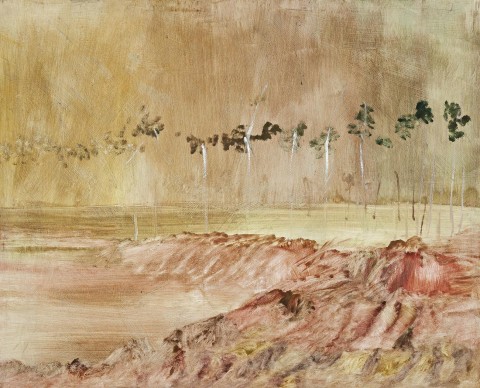WIMMERA LANDSCAPE, c.1965
SIDNEY NOLAN
oil on composition board
121.5 x 150.0 cm
bears inscription verso: 20.
Private collection
Christie’s, Melbourne, 24 November 1992, lot 359 (as ‘Landscape’)
Private collection, United Kingdom
Wimmera, 1966, 121.0 x 153.0 cm, oil on board, exhibited in Sidney Nolan: gemälde und druckgraphik, Kunsthalle Darmstadt, Germany, 15 May – 27 June 1971, cat. 36
Sidney Nolan’s first significant body of work was painted whilst stationed in the Wimmera region of Victoria’s north-west where he (reluctantly) served time in the army in 1942. His appreciation for sun-drenched, harsh landscapes stayed with him and became even more pronounced in his ‘central Australia’ series of 1949 – 1950, the ‘drought’ works from 1953, the second ‘Kelly’ series of the mid-1950s, and on to his African paintings from 1963. This innate understanding also extended to the bleak conditions he encountered in the Antarctic in 1964 and continued to resurface intermittently through his career. Wimmera Landscape, c.1965 is an excellent example of the incorporation of all these influences into one grand vision of a sparse and heated land.
Nolan and his wife Cynthia moved permanently to Europe in 1953 with London as their base, and his career and travels increased exponentially as a result. The mid-1960s was a further period of grand ambition and personal transition for the artist, and a partial overview of his travel itinerary gives some indication: Antarctica, Australia, England in 1964; Australia (again), New Guinea, Indonesia, Nepal, Pakistan, Afghanistan, China and New York in 1965.1 It was a whirlwind life, punctuated by periods of intense studio activity where Nolan created serial imagery based on sketches, photographs and his own fulsome imagination. His painting techniques also varied, from squeegee marks applied to pigment mixed with alkyd resins; oil paint loaded with juicy, thick medium; or washed backgrounds of thin colour rubbed into the board with rags, then scraped back with his fingers. The masterworks from these years are many, and include the multi-panelled epics Riverbend I, 1964 – 65 (Australian National University, Canberra); Riverbend II, 1965 – 66 (News Limited, New York); and Glenrowan, 1966 (Carnegie Museum of Art, Pittsburgh). Whilst all were based on specific locales, such as Victoria’s Goulburn River for the Riverbend paintings, each was also sufficiently removed from reality to create a singular illusory landscape suited to the particular mood of the story Nolan wished to convey.
Wimmera Landscape is a stand-alone image, but was probably painted amidst the creative process of these multi-panelled works. It too is a composite landscape, one which absorbs stylistic notes from the Wimmera, central Australia and even the Serengeti of Africa. There is an almost minimalist quality which stands in stark contrast to the tangled, thick paint which dominates Riverbend I and II. Instead, pigment-loaded squeegee-sweeps in the foreground suggest the banks of an eroded river, and the mirage-like stand of trees across the centre – mere stripes and daubs – hover over the baleful background glow of a desert sky rendered translucent with haze. Although the title of this painting has not been firmly established, Nolan exhibited a work of similar scale (painted in 1966) in Germany in 1971 under the title of Wimmera. It is plausible that this painting originally shared a similar title, as Nolan recognised something of his original Victorian landscape inspiration during his subsequent contemplation of the otherwise intuitive, finished result.
1. See Clarke, J., Sidney Nolan: Landscapes and Legends, exhibition catalogue, National Gallery of Victoria, Melbourne, 1987, p. 23
ANDREW GAYNOR
